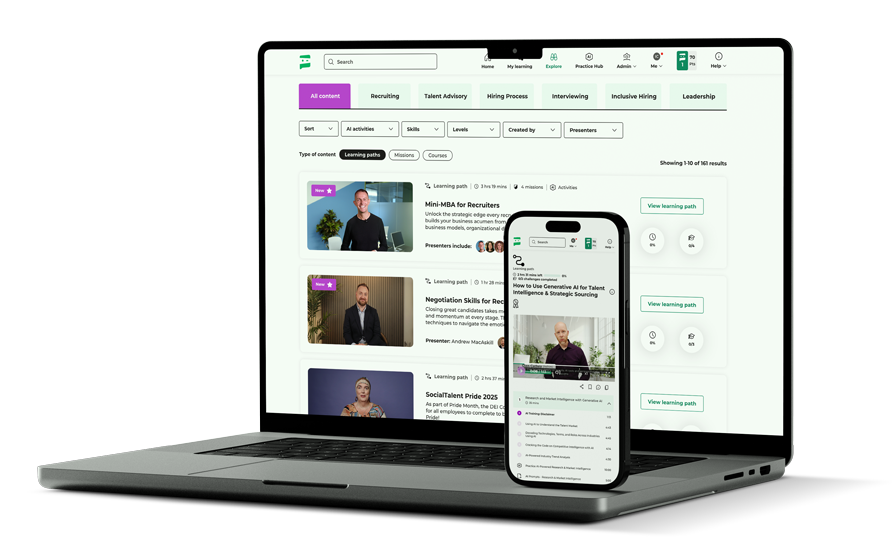
By David Deady
Let’s be real: recruiting in 2025 isn’t the same job it was two years ago. Or even two quarters ago.
AI is rewriting the rules. Candidates show up to interviews with more research than your hiring manager. And talent teams are expected to move fast, think strategically, and somehow still stay human through it all.
It’s a lot.
But here’s the truth hiding in plain sight: the best recruiters right now? They’re not the ones with the fanciest tech stack or the biggest networks. They’re the ones who never stopped learning.
In a world where job descriptions change faster than LinkedIn algorithms, upskilling isn’t a nice-to-have – it’s how you stay relevant, resilient, and really good at what you do.
The good news? You don’t need to go back to school or spend hours watching dry webinars. Upskilling and recruiter training in 2025 is dynamic, bite-sized, and surprisingly fun – when you know where to look. From structured training (hi, SocialTalent!) to real-world practice, mentorship, AI experimentation, and learning from the best minds in the business, this guide breaks down the modern recruiter’s roadmap to leveling up.
Let’s get into it.
1. Embrace Formal Learning: Get Trained, Not Just Trialed
Recruiting often gets treated like something you either “have a knack for” or you don’t. You’re good with people? Great, you’re a recruiter now.
But let’s be honest: natural instincts only take you so far. If you want to go from reactive order-taker to strategic talent partner, you need structure. You need language. You need reps. In short, you need training.
Formal learning gives you a framework – a way to step back from the day-to-day noise and sharpen how you think, not just what you do. It helps you connect the dots between sourcing and strategy, between employer brand and candidate experience, between what the business wants and what the talent market will actually give you.
And in 2025, the best recruiter training isn’t a dusty certification or a one-time workshop. It’s continuous, on-demand, and led by the people shaping the future of hiring.
And look – we could list a bunch of other training vendors here to be diplomatic… but who are we kidding? You’re already in the right place!
SocialTalent has built learning paths for every stage of your recruiting journey – whether you’re figuring out what a req actually is or leveling up into full-blown talent advisory mode. You’ll learn from the greats: Glen Cathey, Holly Fawcett, John Vlastelica, Johnny Campbell. Real experts, not random talking heads.
It’s all bite-sized, binge-worthy, and built to fit around your day – not derail it. No fluff, no filler, just the good stuff you can actually use.
Want to grow? Get formal. Because winging it is no longer a competitive strategy.
Learn more: Want to cut straight to it? Chat to our team today to learn about the the best recruiter training going!
2. Practice Makes Permanent: From ‘Knowing’ to Doing
Let’s face it: most generic recruiter training stops just short of impact. You watch the lesson, maybe take a few notes, feel vaguely smarter – and then freeze the moment you actually need to apply it in the real world.
It’s not your fault. It’s just how most learning is designed and the business of recruiting allows little time or space to hone.
Knowing what to do and actually doing it well are two different beasts. And in recruiting – where conversations, instincts, and judgment calls rule the day – repetition matters. Practice builds the muscle. It turns “I know this” into “I’ve got this.”
That’s exactly why we built Practice Hub and designed AI-powered activities on our learning platform
Instead of leaving your learning in a vacuum, Practice Hub lets you apply what you’ve just learned in realistic, AI-powered scenarios – from building interview scorecards to giving candidate feedback to prepping for tough hiring conversations. It’s structured practice that feels real and not like homework.
Research shows active learners retain up to 93.5% of content versus 79% for passive learners. So yeah – practice really matters. Especially when the stakes are hiring decisions.
This isn’t about role-playing in the mirror. It’s smart, guided, just-in-time practice that helps you show up sharper when it counts. Want to go beyond theory? Start clicking buttons. That’s where the real growth kicks in.
Learn more: Transforming Hiring Skills with Practice Hub
3. Get Yourself a Mentor (Or at Least a Sounding Board)
Upskilling isn’t always about courses or content. Sometimes, it’s about having the right person in your corner – someone who’s made the mistakes already, figured out what works, and is willing to show you the ropes (or at least point you toward them).
In other words: get yourself a mentor.
The best recruiters are curious by default – but curiosity gets supercharged when you’ve got someone to bounce ideas off, sanity-check strategies with, or just vent about your 17th scheduling ping-pong of the day. Whether it’s a seasoned recruiter on your team, a former manager, or someone you admire from afar and finally get brave enough to DM, mentorship is a powerful way to accelerate your learning – and avoid reinventing the wheel.
Don’t overthink it. A mentor doesn’t have to be Gandalf with a sourcing dashboard! They just need experience, empathy, and a willingness to share. And mentorship doesn’t have to be formal either. Some of the best learning moments happen during casual Slack chats, virtual coffees, or mid-rant during a post-interview debrief.
4. Get Comfortable with Tools, AI, and Tactical Curiosity
There’s a myth that to “embrace technology,” you need to be a full-stack dev or have ChatGPT hooked directly into your bloodstream. Not true.
In 2025, being tech-savvy isn’t about mastering every tool – it’s about having the confidence to mess around with them. The best recruiters aren’t waiting for permission or perfection. They’re poking at new tools, testing what works, and figuring out how to use AI to save time, boost quality, or spark better conversations.
We’re talking sourcing extensions. Automation workflows. AI-assisted email writing. Interview question generators. Market intelligence tools. You don’t need to use them all – but you do need to be the kind of recruiter who’s willing to explore. Curiosity is the real skill here.
But here’s the kicker: not every team needs the same tools. Not every recruiter needs the same tactics. So before you rush to plug 14 new Chrome extensions into your life, ask yourself: Where am I right now—and what would actually move the needle?
That’s where our Hiring Excellence Maturity Model comes in. It’s a simple, strategic way to assess where you are across core areas like candidate experience, structures, and use of tech – and get tailored recommendations for how to level up. Whether you’re stuck in passive recruiting or well on your way to talent advisory, the model helps you focus on the tools, processes, and mindset shifts that will make the biggest difference for you.
Learn more: Check out our webinar SocialTalent Live – TA Maturity Models
5. Follow the Leaders: Learn From the Best
Recruiting can be a lonely job. You’re juggling stakeholders, managing candidate expectations, and translating vague job specs into real human potential. Sometimes, it helps to borrow someone else’s brain for a bit.
That’s where thought leaders come in.
Following the right people can radically upgrade your perspective. It’s free learning, real-time trendspotting, and a steady stream of “oh wow, I hadn’t thought of it like that” moments. And in 2025, there’s no shortage of sharp, generous minds sharing their playbooks.
Who should you have in your feed? Start with the ones who’ve been in the trenches:
- Hung Lee – curates Recruiting Brainfood, the must-read weekly newsletter.
- Glen Cathey – deep dives on sourcing, tech, and the evolving recruiter mindset.
- John Vlastelica – the Talent Advisor OG.
- Aubrey Blanche-Sarellano – on inclusion, empathy, and humanity in hiring.
- Josh Bersin, Lou Adler, and Kevin Wheeler.
- And of course, our very own Johnny Campbell, whose Talent Leadership Insights newsletter cuts through the noise on strategy, stakeholdering, and what actually matters in TA.
This isn’t about hero worship. It’s about curating a learning loop that challenges you to think bigger. Comment. Share. Ask questions. Recruiters who engage in the conversation don’t just keep up – they shape where it’s going.
6. Plug Into Community: Events, Conversations, and Collective Brainpower
Here’s a secret most recruiters won’t admit: some of the best learning doesn’t come from courses or content. It comes from conversations.
There’s something powerful about being in a (virtual or physical) room full of people who get it – people who’ve wrestled with the same hiring challenges, tested similar strategies, and come out the other side with lessons, scars, or both. That’s what community gives you: insight, perspective, and the occasional “Wait, you use that tool too?” bonding moment.
Whether it’s industry events, talent roundtables, podcasts, or Slack groups, surrounding yourself with curious peers keeps you sharp – and gives you a much-needed reality check that no one has it all figured out. (They’re just posting confidently on LinkedIn.)
Not sure where to start? We’ve got you covered.
We always have a SocialTalent Live event on the horizon – and it’s completely free. You’ll hear from TA leaders at some of the world’s biggest brands about how they’re tackling some of the most pressing concerns in talent acquisition and hiring. It’s practical, fast-paced, and full of the kind of insights you won’t find in a vendor brochure.
→ Sign up for our next SocialTalent Live here.
Whether you attend live or catch the replay, events like this give you an edge – and remind you you’re not learning in a vacuum. You’re part of a profession that’s growing, evolving, and learning together.
Final Thoughts: Growth Is the Job
Upskilling isn’t extra. It is the job.
Recruiting in 2025 isn’t just about filling roles – it’s about shaping teams, building trust, and staying ahead of a market that moves fast and breaks expectations. And that means sharpening your skills isn’t a once-a-year checkbox. It’s a mindset.
The good news? You don’t have to do it alone – and you don’t have to figure it out as you go.
Whether you’re diving into structured training, testing tools, getting feedback through AI-powered practice, or learning from the industry’s sharpest minds, there are more ways than ever to grow as a recruiter. The only thing that’s non-negotiable is motion.
So ask yourself: What’s the next skill I want to master? Then take the first step toward it today.
And if you’re ready to get serious about growth?
→ Explore SocialTalent’s learning platform
→ Take the Hiring Excellence Maturity Assessment
→ Join us at the next SocialTalent Live
Because the future of hiring belongs to those who are ready to grow into it.




